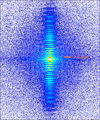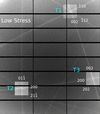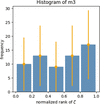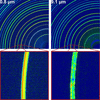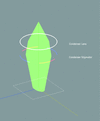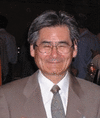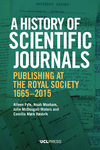issue contents
August 2023 issue

Cover illustration: Lima et al. [J. Appl. Cryst. (2023), 56, 1002–1014] report a systematic investigation on the effect of acid straightening and/or bleaching on the morphology and ultrastructure of hair using a group of complementary experimental methods: wide-, small- and ultra-small-angle X-ray scattering; high-resolution 3D X-ray microscopy; quasi-elastic neutron scattering and inelastic neutron scattering; thermogravimetry–mass spectrometry; and differential scanning calorimetry.
research papers
Open  access
access
 access
accessA rapid ensemble modelling method that optimizes the fit to the small-angle X-ray scattering (SAXS)-derived pair-wise distance distribution function [P(r) versus r] and the measured intensity profile [I(q) versus q] has been used to account for differences between AlphaFold-predicted and experimental SAXS profiles. By considering the confidence levels that come with the predicted structures, a conformational ensemble with potentially flexible linkers between stable folded domains can be optimized to provide representative structures.
A novel methodology using solely small-angle X-ray scattering (SAXS) measurements at multiple temperatures is proposed to determine the coefficients of thermal expansion of confined spherical nanocrystals and/or nanodroplets and the radius dependence of the melting temperature of spherical nanocrystals.
Open  access
access
 access
accessThis article presents some representative examples illustrating the performance of small-angle X-ray scattering and X-ray photon correlation spectroscopy methods with the Extremely Brilliant Source at the European Synchrotron Radiation Facility.
Open  access
access
 access
accessSemi-crystalline polymers present a hierarchical organization of structural levels from ångströms to hundreds of nanometres. By combining small- and wide-angle neutron scattering at the same instrument, such complex morphologies can be resolved under application of relevant humidity and temperature conditions.
Open  access
access
 access
accessUse of the double-gating mode implemented on the modern hybrid photon counting system EIGER2 helps to suppress the influence of beam fluctuations in pump–probe experiments at synchrotron radiation facilities and provides better data quality.
Open  access
access
 access
accessA novel biaxial tensile tester designed to work in combination with 2D synchrotron-based scanning small- and wide-angle X-ray scattering and digital image correlation is described. The available biaxial modes and a proposed sample geometry are discussed.
Small-angle neutron scattering is used to characterize the microstructural changes in building materials treated by various specialist consolidating agents.
Open  access
access
 access
accessSmall- and wide-angle X-ray scattering and asymmetric flow field-flow fractionation integrated with multi-angle light scattering (AF4–MALS) are used to characterize PEGylated liposomes of hydrogenated soy phosphatidylcholine (HSPC) that have potential for drug delivery. Observed local and global structural changes of the phospholipid bilayers reveal the effects of cholesterol on PEGylated HSPC liposomes.
Open  access
access
 access
accessThis publication describes the stable version of a liquid chromatography system combined with the small-angle neutron scattering (SANS) instrument D22 at Institut Laue–Langevin to run size-exclusion chromatography (SEC) immediately before SANS measurement.
Open  access
access
 access
accessA systematic investigation on alterations promoted by acid straightening and/or bleaching in hair microstructures is presented. By combining X-ray scattering methods and microcomputed tomography, among several other methods, innovative results were obtained on the structure and thermodynamics of human hair subjected to cosmetic procedures.
Contrast variation small-angle neutron scattering by dynamic nuclear polarization is applied to the study of human hair microstructure.
Open  access
access
 access
accessThree-dimensional Bragg coherent diffraction imaging with the CITIUS charge-integrating detector is demonstrated.
Open  access
access
 access
access3D-printed mixing high-viscosity extruder devices address time-resolved membrane protein crystallography challenges via compact dual-flow lipidic cubic phase injection.
Open  access
access
 access
accessA new fingerprinting methodology is presented for phase discrimination in complex solid solutions near the morphotropic phase boundary.
This paper discusses the effects of incoherent Compton scattering and fluorescence on X-ray pair distribution function analysis and shows that a noise-to-signal ratio of approximately 1% is the minimum threshold for satisfactory results when analyzing disordered structures with a high Qmax.
Open  access
access
 access
accessA cost-effective capillary dialysis apparatus (Toledo Capillary Box) was developed for biomacromolecule crystal growth in microgravity and unit gravity environments to provide slow equilibration between the precipitant reservoir and capillary solutions. Analytical and semi-analytical models allow the prediction of precipitant equilibration of capillary and reservoir solutions under diffusion-controlled transport and show good agreement with experimental results.
Open  access
access
 access
accessIn situ neutron diffraction is demonstrated as a suitable technique to track phase evolution during synthesis of layered oxide compounds. The synthesis of a series of cathode materials for Li-ion batteries with different Ni/Mn ratio is investigated, in batches comparable to standard laboratory conditions, demonstrating the delayed onset of lithiation with increasing Mn content.
Open  access
access
 access
accessIn this article, a texture-based characterization of surface, sub-surface and bulk residual stress in laser powder bed fused Inconel 718 alloy is carried out. It is shown that, in the case of this nickel-based superalloy, the texture affects the residual stress determination only when it has sufficient strength.
New heterostructures of ZnO monolayers and siligraphene with tunable band gaps for various applications are reported.
This article introduces a generalized approach to determine polydispersity characteristics from small-angle scattering analysis based on the Beaucage model without numerical integration of experimental data.
It is demonstrated that a newly developed superconducting neutron detector, called a current-biased kinetic inductance detector, can be used for crystal orientation mapping based on the Bragg dips observed in a neutron transmission spectrum. The neutron transmission spectra of YbSn3 single crystals were observed up to 100 eV, and crystal orientations were determined.
Open  access
access
 access
accessThe kinetics of precipitation of CaCO3 particles in the presence of polystyrene sulfonate was studied by small- and wide-angle X-ray scattering. Employment of the Porod invariant and the Hurd–Flower model provides essential information on the kinetics.
Two isostructural phase transitions were observed for Bi4O7 during compression under high pressure. The pressure–volume curve was found to be discontinuous at the two pressure transition boundaries. Fitting the curves of the three different stages revealed large differences in the bulk moduli, confirming the two isostructural phase changes.
Open  access
access
 access
accessA new methodology is demonstrated for analyzing spatial temperature distributions using modeling and machine learning. The method is applied to X-ray data gathered during in situ laser melting.
Open  access
access
 access
accessRepresentative volume elements for diffraction-based stress/strain distributions in polycrystalline materials are compared with direct-space values of these quantities using numerical modelling. The results indicate that these volumes and their stress states are equivalent under very specific conditions.
A generalized Zimm plot approach is outlined for quantifying molecular deformation of polymer melts. Combined with the spherical harmonic expansion technique, the proposed method provides several benefits for understanding the small-angle neutron scattering spectra of deformed polymers, including a tensorial extension of the Guinier law and direct visualization of spatially dependent deformation.
This study describes ten-shell nested fully annular quasi-ellipsoidal focusing mirrors with an m = 3 Ni/Ti supermirror coating for small-angle neutron scattering. The proposed mirrors have been developed to gain enough neutrons on a sample for the specified minimum wavevector transfer Q and the results demonstrate adaptability for instruments with changeable sources.
Symmetry-mode analysis is used to detect and characterize structural distortions from pair distribution function data by refining mode amplitudes directly. This approach is successfully applied to a subtle but long-range distortion in TiSe2 and also to a large but highly localized distortion in MnTe. Two new open-source Python packages, isopydistort and isopytools, were used to carry out this analysis within the open-source DiffPy framework.
Open  access
access
 access
accessA new robust indicator for low-energy contamination is presented and applied to experimental data. The standard correction procedure for low-energy contamination is improved.
Open  access
access
 access
accessA semi-automated workflow is described for rapid-scanning powder X-ray diffraction and pair distribution function experiments. The software infrastructure saves metadata and raw and analyzed files into a collection stored on the local hard drive for easier reuse.
An approach to fast fitting of crystal electric field parameters to any experimental data is presented. This approach is implemented in a lightweight Python-based program, CrysFieldExplorer.
Open  access
access
 access
accessThis work reports in situ neutron diffraction experiments on a broad range of grain sizes of barium titanate. The study reveals the grain-size-dependent strain mechanisms and shows the competitiveness of neutron diffraction with high-resolution synchrotron diffraction.
The LUOSHU small-angle neutron scattering instrument is designed to provide a wide scattering vector magnitude (Q) range of four orders of magnitude by 46 m total length, for studies of nano-particles ranging from the sub-nanometre to the sub-micrometre scale in numerous fields. A high dynamic Q range (Qmax/Qmin) is realized by a unique three-detector system, for better efficiency in experiments. High-flux and high-resolution modes are ensured by two switchable velocity selectors, for more flexibility in different situations.
short communications
Open  access
access
 access
accessThe paired refinement procedure was applied on diffraction data from binder H33 corrected for strong diffraction anisotropy.
PDB reference: 8bdu
computer programs
Open  access
access
 access
accessTEMGYM Basic is a Python-based ray-tracing tool for novel experiment visualization and an interactive learning environment for using transmission electron microscopes.
Open  access
access
 access
accessThe MAUD Interface Language Kit (MILK) provides a Python interface to the Rietveld software MAUD, enabling scriptable refinements. The MILK framework includes parallel computing and folder management which enable high-throughput Rietveld analysis, visualization and validation.
Open  access
access
 access
accessShape2SAS allows the user to simulate solution small-angle scattering data and pair distance distributions from user-defined shapes. The program is available as a web application, and is useful for teaching and tutorials, as well as for checking the validity of analytical form factors.
Open  access
access
 access
accessAn upgrade to the D+ software is presented, simulating the 2D scattering pattern from structures with a single orientation or fibers. An upgraded independent D+ Python API is described, including structure factor, polydispersity and several other features.
crystallographers
Free 

Free 

book reviews
Free 


 journal menu
journal menu












